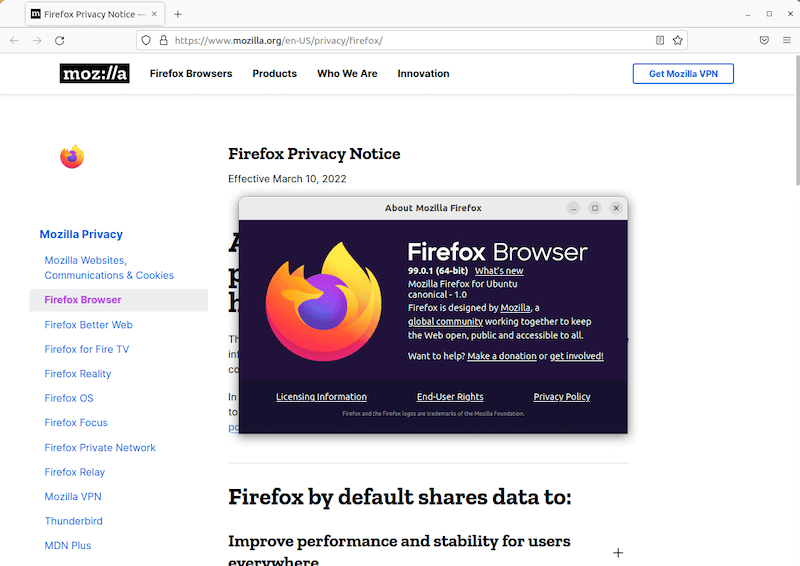How To Install Mozilla Firefox on Linux Mint 22

Mozilla Firefox stands as a beacon of open-source browsing, offering users a blend of speed, security, and customization. For Linux Mint 22 users, installing this popular web browser opens up a world of enhanced online experiences. This guide will walk you through various methods to get Firefox up and running on your system, ensuring you have access to the latest features and security updates.
Introduction
Firefox has long been a favorite among Linux users, known for its commitment to privacy and its extensive library of add-ons. As web technologies evolve, keeping your browser up-to-date becomes crucial. The latest version of Firefox not only provides improved performance but also incorporates cutting-edge security features to protect you from online threats.
Linux Mint 22, with its user-friendly interface and stability, pairs excellently with Firefox. Whether you’re a seasoned Linux user or new to the Mint ecosystem, this guide aims to provide clear, step-by-step instructions for installing Firefox. We’ll explore multiple installation methods, each with its own set of advantages, allowing you to choose the one that best suits your needs and technical comfort level.
Prerequisites
Before diving into the installation process, ensure that your system meets the following requirements:
- A computer running Linux Mint 22 (Vera)
- An active internet connection
- Basic familiarity with terminal commands
- Sufficient disk space (approximately 200MB for Firefox)
It’s also recommended to update your system before proceeding. Open a terminal and run:
sudo apt update && sudo apt upgradeThis ensures that your system has the latest packages and dependencies, which can prevent potential issues during the Firefox installation.
Methods to Install Firefox
We’ll explore three primary methods to install Firefox on Linux Mint 22. Each approach has its merits, and the choice depends on your preferences for stability, update frequency, and system integration.
Method 1: Using the Default Linux Mint Repositories
This method is the simplest and most straightforward, utilizing the built-in package management system of Linux Mint.
Step 1: Update Repository Information
Open a terminal and run:
sudo apt updateThis command refreshes your system’s package lists, ensuring you have the most up-to-date information about available software.
Step 2: Install Firefox
With the repository information updated, install Firefox by executing:
sudo apt install firefoxThe system will download and install Firefox along with any necessary dependencies.
Step 3: Verify Installation
To confirm that Firefox has been installed correctly, run:
firefox --versionThis command will display the version of Firefox installed on your system.
Advantages and Disadvantages
Pros:
- Simple installation process
- Automatic updates through the system’s package manager
- Guaranteed compatibility with Linux Mint 22
Cons:
- May not always have the latest Firefox version immediately available
- Limited control over update timing
Method 2: Installing Firefox Directly from Mozilla
For users who prefer to have the latest Firefox version as soon as it’s released, installing directly from Mozilla is an excellent option.
Step 1: Download the Latest Version
Use the wget command to download the latest Firefox package:
wget -O firefox-latest.tar.bz2 "https://download.mozilla.org/?product=firefox-latest&os=linux64&lang=en-US"This command downloads the latest 64-bit English version of Firefox. Adjust the URL if you need a different language or architecture.
Step 2: Extract and Move Files
Extract the downloaded archive:
tar xjf firefox-latest.tar.bz2Move the extracted folder to the /opt directory:
sudo mv firefox /opt/firefox-latestStep 3: Create a Symlink
Create a symbolic link to make Firefox accessible system-wide:
sudo ln -s /opt/firefox-latest/firefox /usr/bin/firefoxStep 4: Launch Firefox
You can now launch Firefox by typing firefox in the terminal or by finding it in your application menu.
Pros and Cons
Pros:
- Access to the latest Firefox features immediately upon release
- Direct control over updates
- Can coexist with repository-installed versions
Cons:
- Manual update process required
- Potential for compatibility issues with system libraries
- Not integrated with the system’s package manager
Method 3: Using Mozilla’s APT Repository
This method combines the benefits of using a package manager with the timeliness of updates from Mozilla’s official repository.
Step 1: Uninstall Existing Firefox Snap (if applicable)
If you have a Snap version of Firefox installed, remove it first:
sudo snap remove firefoxStep 2: Set Up APT Keyring
Create a directory for the APT keyring:
sudo install -d -m 0755 /etc/apt/keyringsStep 3: Import Mozilla APT Repository Key
Download and add Mozilla’s repository signing key:
wget -q https://packages.mozilla.org/apt/repo-signing-key.gpg -O- | sudo tee /etc/apt/keyrings/packages.mozilla.org.asc > /dev/nullStep 4: Add Mozilla Repository to Sources List
Add Mozilla’s repository to your system’s sources:
echo "deb [signed-by=/etc/apt/keyrings/packages.mozilla.org.asc] https://packages.mozilla.org/apt mozilla main" | sudo tee /etc/apt/sources.list.d/mozilla.list > /dev/nullStep 5: Configure APT Preferences
Set up APT preferences to prioritize Mozilla’s repository:
echo '
Package: *
Pin: origin packages.mozilla.org
Pin-Priority: 1000
' | sudo tee /etc/apt/preferences.d/mozillaStep 6: Install Firefox from Mozilla Repository
Update your package lists and install Firefox:
sudo apt-get update && sudo apt-get install firefoxBenefits and Drawbacks
Benefits:
- Faster access to updates compared to default repositories
- Integration with system package management
- Official Mozilla-supported installation method
Drawbacks:
- Slightly more complex initial setup
- Potential for conflicts with other Firefox installations
Troubleshooting Common Issues
Even with clear instructions, you might encounter some hurdles during the installation process. Here are solutions to common issues:
Missing Dependencies
If you encounter missing dependencies when installing Firefox, try running:
sudo apt-get install -fThis command attempts to fix broken dependencies automatically.
Repository Key Issues
If you receive GPG errors when adding Mozilla’s repository, ensure that you’ve correctly imported the signing key. You can try re-importing the key:
sudo apt-key adv --keyserver keyserver.ubuntu.com --recv-keys A6DCF7707EBC211FFirefox Won’t Launch
If Firefox doesn’t start after installation, try the following:
- Check for running Firefox processes:
ps aux | grep firefox - Kill any existing processes:
killall firefox - Launch Firefox from the terminal to see any error messages:
firefox

Updating and Reinstallation
To update Firefox installed via APT:
sudo apt-get update && sudo apt-get upgrade firefoxFor a clean reinstallation:
sudo apt-get purge firefox
sudo apt-get update
sudo apt-get install firefoxCongratulations! You have successfully installed Firefox. Thanks for using this tutorial for installing the Firefox browser on Linux Mint 22 system. For additional help or useful information, we recommend you check the official Mozilla website.